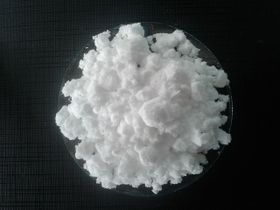Potassium persulfate

| |
| Names | |
|---|---|
| Systematic IUPAC name
Potassium peroxydisulfate | |
| Other names
Dipotassium peroxodisulfate
Potassium perdisulfate Potassium peroxydisulfate | |
| Identifiers | |
| Jmol-3D images | Image |
| |
| Properties | |
| K2S2O8 | |
| Molar mass | 270.322 g/mol |
| Appearance | White solid |
| Density | 2.477 |
| Melting point | 186–250 °C (367–482 °F; 459–523 K) (decomposes) |
| Boiling point | Decomposes |
| 1.75 g/100 mL (0 °C) 4.49 g/100 ml (20 °C) | |
| Solubility | Soluble in conc. hydrogen peroxide[1], hydrogen fluoride[2] Insoluble in benzene, ethanol, methanol |
| Thermochemistry | |
| Std enthalpy of
formation (ΔfH |
-1,916 kJ/mol[3] |
| Hazards | |
| Safety data sheet | ScienceLab |
| Flash point | Non-flammable |
| Lethal dose or concentration (LD, LC): | |
| LD50 (Median dose)
|
802 mg/kg (oral, rat) |
| Related compounds | |
| Except where otherwise noted, data are given for materials in their standard state (at 25 °C [77 °F], 100 kPa). | |
| Infobox references | |
Potassium persulfate, also known as potassium peroxydisulfate is a chemical compound used as an oxidizing agent, with the formula K2S2O8.
Contents
Properties
Chemical
When potassium persulfate is heated in a 50% aqueous solution of sulfuric acid, hydrogen peroxide results, which, due to the high temperature, distills from the solution. The H2O2 obtained this way has a concentration of 40-60%. This method was previously used in the manufacturing of hydrogen peroxide on industrial scale before being replaced by the quinone process.
Potassium persulfate will react with silver nitrate to form silver(I,III) oxide (silver peroxide):[4]
- K2S2O8 + AgNO3 → Ag4O4 + K2SO4 + SOx + NOx + Ox
Potassium peroxydisulfate oxidizes acetone in the presence of diluted sulfuric acid and silver metal to acetic acid, releasing carbon dioxide:[5]
- 2 K2S2O8 + (CH3)2CO → CH3COOH + KHSO4 + CO2
Reaction with nitric acid gives off oxygen and ozone fumes, and nitrogen as byproduct.[6]
Physical
Potassium persulfate is a white crystalline solid, poorly soluble in water. It decomposes if heated to temperatures over 125°C. It has a density of 2.477 g/cm3.
Availability
Potassium persulfate can be bought from chemical suppliers and eBay.
Preparation
The most common way to synthesize potassium persulfate is via the electrolysis of a cold solution potassium bisulfate in sulfuric acid, at a high current density[7]:
- 2 KHSO4 → K2S2O8 + H2
Tantalum electrodes can be used in this reaction.[8]
Bubbling elemental fluorine through an aqueous solution of KHSO4 or K2SO4 will also yield potassium peroxydisulfate. The reaction also works in the absence of water.[9][10]
It can also be prepared by adding KHSO4 to a solution of the more soluble salt ammonium peroxydisulfate. Potassium persulfate will precipitate from this reaction.
Projects
- Make silver peroxide
Handling
Safety
Potassium peroxydisulfate is a strong oxidizer and should be handled with care.
Potassium persulfate will slowly decompose in wet environment.
Storage
Potassium persulfate should be stored in closed bottles, away from any acidic vapors or organic materials.
If kept in a dark and dry environment, it will remain stable for years.[11]
Disposal
Heating the salt will cause it to decompose.
References
- ↑ Skogareva; Ippolitov; Russian Journal of Inorganic Chemistry; vol. 43; nb. 11; (1998); p. 1668 - 1670
- ↑ Fredenhagen, H.; Z. Anorg. Chem.; vol. 242; (1939); p. 23 - 32
- ↑ Balej, Jan; Zeitschrift fur Physikalische Chemie; vol. 224; nb. 6; (2010); p. 883 - 892
- ↑ Marshall, H.; Journal of the Chemical Society; vol. 59; (1891); p. 775
- ↑ Broensted, J. N.; Z. phys. Ch.; vol. 102; (1922); p. 169 - 207
- ↑ Baeyer, A.; Villiger, V.; Ber.; vol. 34; (1901); p. 853 - 862
- ↑ F. Feher, "Potassium Peroxydisulfate", Handbook of Preparative Inorganic Chemistry, 2nd Ed. Edited by G. Brauer, Academic Press, 1963, NY. Vol. 1. p. 392.
- ↑ Gmelin, vol. O: MVol.2; 46, page 276 - 278
- ↑ Fichter, F.; Humpert, K.; Helvetica Chimica Acta; vol. 9; (1926); p. 521 - 525
- ↑ Mueller, E.; Zeitschrift fuer Elektrochemie; vol. 10; (1904); p. 753 - 776
- ↑ Elbs, K.; Neher, P.; Chemiker-Zeitung; vol. 45; (1921); p. 1113 - 1114
Relevant Sciencemadness threads
- Chemical pages without CAS Registry Number
- Articles without EBI source
- Chemical pages without ChemSpiderID
- Chemical pages without DrugBank identifier
- Articles without KEGG source
- Articles without InChI source
- Articles without UNII source
- Articles containing unverified chemical infoboxes
- Chemical compounds
- Inorganic compounds
- Potassium compounds
- Persulfates
- Oxidizing agents
- Materials that react with water